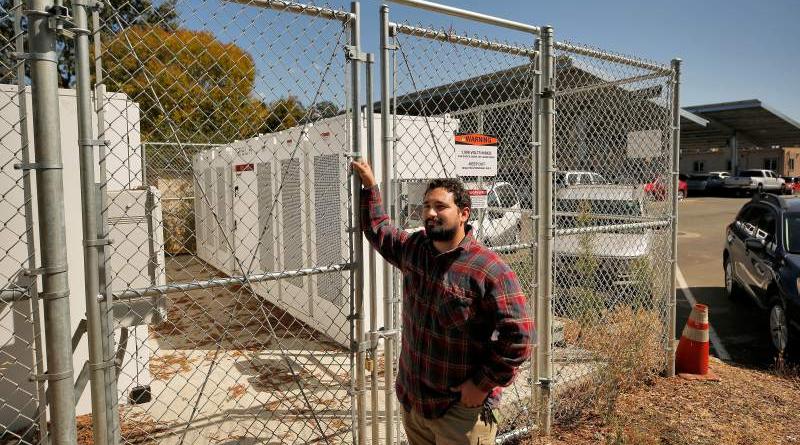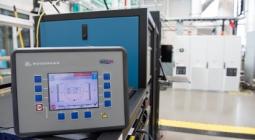Greater wildfire risks prompt growth of electrical ‘microgrids’ to rely less on PG&E.

In his standard blue jeans and unbuttoned flannel shirt, David Liebman could blend in with many of the young students walking to and from classes at Santa Rosa Junior College.
But Liebman, manager of energy and sustainability for the college district, has something bigger on his mind than class assignments and midterm projects.
Liebman, 27, is heading a $5 million electrical infrastructure project that addresses climate change and fundamentally will transform the way energy is distributed and used on campus.
Using the new solar arrays at the Santa Rosa campus, Liebman is coordinating the development of an electrical microgrid that could operate independently of PG&E during nearby wildfires, or when the escalating threats of fires in the age of climate change prompt the utility to temporarily turn off power.
“Unless we change the infrastructure that runs our society, we’re going to be in a lot of trouble because we won’t be able to adapt to the significant changes that are happening to both the environment and technology in general,” Liebman said.
Fueled by solar energy and equipped with battery storage and a complex control system, the SRJC project is a small part of a much larger movement environmental experts say could fundamentally flip the paradigm on energy usage here and across the country. Before, massive power plants were turned on to meet demand for electricity; now, microgrids could help do that with available renewable energy such as solar, wind and geothermal.
In Sonoma County, microgrid systems would allow key institutions such as hospitals, municipal utilities, a college campus and certain government agencies to continue to operate in the event of a natural disaster that interrupts PG&E’s electrical transmission and distribution.
Local interest in microgrids has heightened with the prospect of Pacific Gas & Electric shutting off power during times of high fire risk.
To provide a model for developing the mini-power networks, a microgrid laboratory has risen just west of the town of Sonoma, at the Stone Edge Farm Estate Vineyards & Winery. The multimillion-dollar microgrid — a testing ground for the latest renewable energy and storage and control technology — encircles 16 acres of vineyards, olive trees and fields of heirloom vegetables and fruit.
A microgrid builder’s dream, the property is regularly visited by college students, government officials and experts in renewable energy, and it often inspires more practical possibilities for people like Liebman.
“We’re able to be a sandbox for clean technology innovation and a living laboratory where our lessons learned are able to feed into improved energy projects in the future,” said Robert Furber, operations analyst for Wooster Energy Engineering, which designed Stone Edge Farm’s microgrid.
Meanwhile, alternative energy advocates say that each microgrid that comes online, with its renewable energy sources, storage capacity and sophisticated control systems, makes the larger electrical power grid less reliant on fossil fuel power plants.
Breaking ‘utility model’
“It breaks the utility model,” Liebman said. “The utility can no longer be a centralized authority for electricity generation. This is going to shift a lot of the utilities into poles and wire companies that manage the distribution grid.”
Liebman said advances in renewable energy, battery storage technology and smart grid controls are helping pave the way to a future when every household, building or property has the potential to be an energy generator, user and mini-grid operator.
At the Santa Rosa campus, Liebman’s project, funded by a grant from the California Energy Commission, would require the addition of two more batteries specialized for use in microgrids. The campus currently has a 1-megawatt Tesla battery system for storage.
The Tesla battery system cost roughly $1.6 million and was acquired with money from the college district’s $410 million Measure H facilities bond voters approved in 2014 for new construction and other campus projects. SRJC also bought the new solar arrays with Measure H funds. The cost of the battery was partly offset by an $800,000 rebate from the state.
The single Tesla battery, operating without extra battery storage and an advanced microgrid control system, is currently being used to help meet peak electricity demand at the campus.
When the microgrid is fully built, the system will allow the campus to optimize its daily electricity consumption, taking into account such things as demand and the cost of power. It also will allow the campus to become a stable point in the larger utility grid, using electricity smarter and more efficiently, plus storing excess energy for discharge into the PG&E grid when needed.
And of course, it would allow the campus to maintain essential services during preemptive power shut-offs by PG&E.
During a fire or other natural disaster, the campus would have power and could be an emergency shelter for area residents, Liebman said.
The growth of microgrids in California, as well as some parts of the western United States, has been mainly driven by years of wildfires and the ongoing threats of more disastrous infernos, said Michael Burr, director of the Microgrid Institute, a national organization formed six years ago to support the planning and implementation of microgrids.
Burr said the institute, which is engaged in projects from California to Massachusetts, has seen a sharp increase in microgrid investments. The global microgrid market is worth about $20 billion in annual investments, and increasing at a rate of 10% a year, he said.
“We predict the market will double in about five years,” Burr said. “We’ll probably see a $100 billion market by 2030.”
Burr said one of the things driving the growth of microgrid investments is the rapid decrease in batteries needed for microgrid power storage. Microgrids and increased storage capacity, he said, have the potential to alleviate the negative effect excess solar production can have on the utility’s power grid.
Microgrid utopia
The Stone Edge Farm microgrid is equipped with 10 solar arrays installed on eight of the property’s 16 buildings. They produce approximately 215,000 kilowatt-hours of energy a year, enough to power 21 homes, said Furber, the operations analyst for Wooster Energy Engineering.
That electricity is transmitted by a high voltage central power line that connects all seven PG&E metered entries at the site.
The microgrid is equipped with numerous energy storage systems, including a Tesla battery system of five 50-kilowatt packs and an electrolyzer that allows for bulk energy storage in the form of pressurized hydrogen gas. Housed in what looks like a shipping container, a new electrolyzer uses solar energy and water to produce hydrogen with oxygen as a byproduct.
Stored as compressed gas, the hydrogen can be used to power fuel cell vehicles, Furber said. The microgrid is owned by Mac and Leslie McQuown, owners of farm and winery.
Furber said as a testing ground for the latest microgrid advances Stone Edge Farm includes much more than a practical microgrid.
“This system is more complicated than most need to be,” he said.
PG&E’s response
The interest in greater energy independence comes at a time when PG&E has been severely weakened by a series of destructive and deadly wildfires in 2017, including the Tubbs fire in October that devastated the Santa Rosa area, and in 2018, when the Camp fire torched Paradise in Butte County and became the deadliest blaze in state history. Early this year, the state’s largest utility sought Chapter 11 bankruptcy under the weight of an estimated $30 billion in fire-related liabilities.
Since then, PG&E has implemented a number of initiatives to curtail future wildfire risks, including safety inspections of tens of thousands of transmission poles and thousands of miles of transmission lines in areas with the highest wildfire risks.
Other measures include removal of vegetation near transmission lines in the most fire-prone areas and enhancing the utility’s real-time monitoring of potential wildfire areas through new weather stations and hundreds of high-definition cameras.
Arguably PG&E’s most direct response to the development of microgrids is the establishment of resilience zones, designated areas in cities and towns that can be isolated from its wider power grid if the utility turns off power. Once disconnected from the grid, the utility can continue to provide electricity to key community sites using a temporary, mobile power generator.
Quinn Nakayama, PG&E’s director of integrated grid planning and innovation, said resilience zones would keep electricity flowing on “main street,” powering important community resources such as fire stations, gas stations and hospitals.
PG&E expects to complete a test resilience zone in Angwin in Napa County by fall. The project, a partnership between the utility and Pacific Union College, would power a number of customers, including the local fire station, gas station and student housing for the college, if the utility turns off electricity to help prevent a fire, Nakayama said.
Another resilience zone is being designed in Calistoga, said Joe Herr, a senior manager on Nakayama’s team.
Nakayama said the cost of establishing a resilience zone is significantly less than a microgrid, since the power generation is only temporary. Mobile generators can be transported from one zone to another, depending on the wildfire threat forecast.
Sutter getting greener
At Sutter Santa Rosa Regional Hospital, the first steps toward a microgrid were completed this summer with the installation of a 1.6-megawatt solar array throughout the campus. The solar system was built and installed by Ameresco Inc., a company that builds, owns, operates and maintains green energy infrastructure for large customers nationwide.
The hope is to one day complete a microgrid at the hospital campus, after adding battery storage and control systems, said William Agate, vice president in charge of microgrid services at Ameresco.
Agate said Sutter recognizes the need to address the effect of potential preemptive power shut-offs by PG&E. A microgrid, which is constantly monitoring what forms of energy generation and storage are being used at any given time, lets people consume energy more wisely, he said.
“It addresses climate change and gives people the choice of where they get their power,” Agate said. “It’s not the only answer, but it certainly is one of the answers.”
Linking power
For Geof Syphers, CEO of Sonoma Clean Power, microgrids are part of a larger effort to gain energy independence from PG&E’s distribution monopoly in Northern California. Instead of relying on a large corporation’s efforts to migrate toward renewable sources of energy, like solar and wind, a microgrid makes everyone a participant in reducing a community’s carbon footprint, he said.
“In the old days, we turned on and off power plants to meet the demand for electricity,” Syphers said. “But today, we’re turning on and off the demand for electricity to meet the available renewable energy supply.”
Syphers said a microgrid really begins with the installation of backup power systems and storage at locations such as community centers, hospitals and cellphone towers. From there, the sites are linked together with control systems, using electricity between them in smarter ways that regulate power use based on available resources.
“Renewable energy is made when the sun shines and the wind blows,” Sypher said. “You have to be able to adjust how much energy you’re using to support a renewable future.”
You can reach Staff Writer Martin Espinoza at 707-521-5213 or martin.espinoza@pressdemocrat.com. On Twitter @pressreno.
14 September 2019
The Press Democrat




